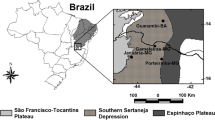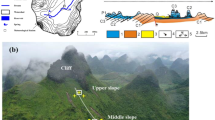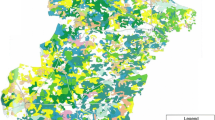Abstract
Studies on soil patterning on a small scale in arid and semi-arid regions have rarely been conducted. Many papers implicitly assume that plant distribution is controlled by some soil variables acting at small scales. We have directly tackled the relationships between soil and some biotic variables including plant distribution at small scales in an Iberian semi-arid gypsum environment. This has been carried out by means of Canonical Correspondence Analysis as a hypothesis-testing tool. CCA models show that the spatial data matrix is able to explain a relevant fraction of the soil data set (P < 0.001). The most important variable, as firstly selected in the CCA stepwise selection procedure, suggests the existence of a vegetation-elevation gradient in relation to soil physical properties; the rest of selected variables indicates the existence of other spatial trends which may be related to certain microgeomorphological features. On the other hand, only the cover of annuals and the cover of litter are selected in the case of the biotic data set as constraining matrix, but not the cover of any perennial plant. Partial CCA models indicated that the remaining information explained by the spatial data set after adjusting the biotic set as covariables is also significant (p < 0.001). This variability is not related to the existence of vegetation bands as shown by the two selected variables in the case of the partial CCA models. The primary source of spatial soil variation is related to the existence of three community bands and these differences are able to explain even the change of plant life forms in vegetated band. The soil parameters controlling the changes are mainly related to texture and surface features. However, we detected other sources of spatial soil variation out of this primary model. This hierarchical spatial pattern seems to be related to some geomorphological traits of the landscape, such as soil crust strength, presence of gypsum crystals or bare zones, and not to the presence of mature gypsophytes (at least the five most frequent) which might ameliorate the soil environment. Furthermore, the biotic data set is not able to explain any new fraction of soil variability out of that already explained by the spatial data set.
Similar content being viewed by others
References
Arslan A 1995 A computer program to express the properties of gypsiferous soils. Can. J. Soil Sci. 75, 459–462.
Artieda O 1993 Factores geológicos que inciden en el desarrollo de los suelos en un medio semiárido. El caso de Quinto (Zaragoza). Tesis de Licenciatura. Universidad de Zaragoza, Spain. 305 p.
Barbour M G and Díaz D V 1973 Larrea plant communities on bajada and moisture gradients in the United States and Argentina. Vegetatio 28, 335–357.
Borcard D and Legendre P 1994 Environmental control and spatial structure in ecological communities: an example using Oribatid mites (Acari, Oribatei). Ecol. Monog. 27, 325–349.
Borcard D, Legendre P and Drapeau P 1992 Partialling out the spatial component of ecological variation. Ecology 73, 1045–1055.
Borselli L, Biancalani R, Giordani C, Carnicelli S and Ferrari G A 1996 Effect of gypsum on seedling emergence in a kaolinitic crusting soil. Soil Technol. 9, 71–81.
Boukhris Mand Loissant P 1975 Aspects ecologiques de la nutrition minerale de plantes gypsicoles di Tunisie. Rev. Ecol. Biol. Sol. 12, 329–348.
Bowers M A 1988 Plant associations on a Sonoran Desert bajada: geographical correlates and evolutionary source pools. Vegetatio 74, 107–112.
Bowers M A and Lowe C H 1986 Plant-form gradients on Sonoran Desert bajadas. Oikos 46, 284–291.
Callaway R M and D'Antonio C M 1991 Shrub facilitation of coast live oak establishment in Central California. Madroño 38, 158–169.
Chapin F S III, Walker L R, Fastie C L and Sharman L C 1994 Mechanisms of primary succession following deglaciation at Glacier Bay, Alaska. Ecol. Monog. 64, 149–175.
Coetzee M A S and Rogers K H 1991 Environmental correlates of plant species distribution on the Nyl River floodplain. Sth. Afr. J. Aquat. Sci. 17, 44–50.
Daiyuan P, Bouchard A, Legendre P and Gérald D 1998 Influence of edaphic factors on the spatial structure of inland halophytic communities: a case study in China. J. Veg. Sci. 9, 797–804.
Dunkerley, D L 1997 Banded vegetation: development under uniform rainfall from a simple cellular automaton model. Plant Ecol. 129, 103–111.
Duvigneaud P and Denaeyer de Smet S 1968 Essai de classification chimique (éléments minéraux) des plantes gypsicoles du bassin de l'Ebre. Bulletin de la Société Royale de Botanique de la Belgique 101, 279–291.
Eilertsen O, Økland R H, Økland T and Pedersen O 1990 Data manipulation and gradient length estimation in DCA ordination. J. Veg. Sci. 1, 261–270.
Eldridge D J, Westoby Mand Holbrook K G 1991 Soil-surface characteristics, microtopography and proximity to mature shrubs: effects on survival of several cohorts of Atriplex vesicaria seedlings. J. Ecol. 78, 357–364.
Escudero A, Carnes L F and Pérez-García F 1997. Seed germination of gypsophytes and gypsovags in semi-arid central Spain. J. Arid Environ. 36, 487–497.
Escudero A and Pajarón S 1994 Numerical syntaxonomy of the Asplenietalia petrarchae in the Iberian Peninsula. J. Veg. Sci. 5,76–85.
Escudero A, Somolinos R C, Olano J M and Rubio A 1999 Factors controlling the establishment of Helianthemum squamatum, and endemic gypsophile of semi-arid Spain. J. Ecol. 87, 1–13.
Escudero A, Iriondo J M, Olano J M, Rubio A and Somolinos R C How is a gypsophyte established? The case of Lepidium subulatum (Cistaceae). Am. J. Bot. (In press).
Eswaran H and Zi-Tong G 1991 Properties Genesis Classification and Distribution of Soils with Gypsum. SSSA Special Publication n. 26, pp In occurence, characteristics and genesis of carbonate, gypsum and silica accumulation in soils. Ed. W D Nettleton 89–119. Soil Sci. Soc. Amer., Madison, Wisconsin.
Fowler N 1986 The role of competition in plant communities in arid and semiarid regions. Ann. Rev. Ecol. Syst. 17, 89–110.
García Moya E and Mckell C M 1970 Contribution of shrubs to the nitrogen economy of a desert wash plant community. Ecology 51, 81–88.
Guerrero-Campo J, Alberto F, Hodgson J, García-Ruiz J M and Montserrat-Martí G 1999a Plant community patterns in a gypsum area of NE Spain. I: Interactions with topographic factors and soil erosion. J. Arid Environ. 41, 401–410.
Guerrero-Campo J, Alberto F, Maestro M, Hodgson J and Montserrat-Martí G 1999b Plant community patterns in a gypsum area of NE Spain. II: effects of ion washing on topographic distribution of vegetation. J. Arid Environ: 411–419.
Gutiérrez J R, Meserve P L, Contreras L, Vásquez C H and Jaksic F M1993 Spatial distribution of soil nutrients and ephemeral plants underneath and outside the canopy of Porlieria chilensis shrubs (Zygophyllaceae) in arid coastal Chile. Oecologia 95, 347–352.
Higgins S, Rogers K H and Kemper J 1997 A description of the functional vegetation pattern of a semi-arid floodplain South Africa. Plant Ecol. 129, 95–101.
Hook P B, Burke I C and Lauenroth WK 1991 Heterogeneity of soil and plant N and C associated with individual plants and openings in North America short-grass steppe. Plant Soil 138, 247–256.
Jackson R B, Manwaring, J H and Caldwell M M 1990 Rapid physiological adjustment of roots to localized soil enrichment. Nature 344, 58–60.
Johansen J R 1993 Cryptogamic crusts of semiarid and arid lands of North America. J. Phycol. 29, 140–147
John E and Dale M R T 1990 Environmental correlates of species distributions in a saxicolous lichen community. J. Veg. Sci. 1, 385–392.
Kruger F J, Mitchell D T and Jarvis J U M (eds) 1983 Mediterranean-Type Ecosystems. The role of nutrients. Ser. Ecological Estudies, 43. Springer-Verlag, Berlin. 552 p.
Lavorel S, Lebreton J, Debussche M and Lepart J 1991 Nested spatial patterns in seed bank and vegetation or Mediterranean old fields. J. Veg. Sci. 2, 367–376.
Le Houérou H N 1986 The desert and arid zones of northern Africa. In Hot Deserts and Arid Shrublands B. Ecosystems of the World 12B. Eds M Evenari and DW Goodall. pp 101–148. Elsevier, Amsterdam.
Legendre P and Anderson M J 1999 Distance-based redundancy analysis: testing multispecies responses in multifactorial ecological experiments. Ecol. Monogr. 69, 1–24.
Legendre P and Fortin M J 1989 Spatial pattern and ecological analysis. Vegetatio 80, 107–138.
Loveday J and McIntyre S 1974 Methods for analysis of irrigated soils. Tech. Com. no 54 of the Commonwealth Bureau of Soils. pp 135–137.
MacMahon J A and Wagner F H 1985 The Mojave Sonoran and Chihuahuan deserts of North America. In Hot Deserts and Arid Shrublands A. Ecosystems of theWorld 12A. EdsME venari and D W Goodall. pp 105–202. Elsevier, Amsterdam.
McAuliffe J R 1994 Landscape evolution soil formation ecological patterns and processes in Sonoran Desert Bajadas. Ecol. Monog. 64, 111–148.
McCune B 1997 Influence of noisy environmental data on canonical correspondence analysis. Ecology 78, 2617–2624.
Meyer S E 1986 The ecology of gypsophile endemism in the Eastern Mojave desert. Ecology 67, 1303–1313.
Meyer S E and García-Moya E 1989 Plant community patterns and soil moisture regime in gypsum grassland of north central Mexico. J. Arid Environ. 16, 147–155.
Meyer S E, García-Moya E and Lagunes Espinoza A L C 1992 Topographic and soil effects on gypsophile plant community patterns in Central Mexico. J. Veg. Sci. 3, 429–429.
Monturiol F and Alcalá del Olmo L 1990 Mapa de asociaciones de suelos de la Comunidad de Madrid. Escala 1:200.000. C.S.I.C, Madrid, Spain. 71 p.
Moro M J, Pugnaire F I, Haase P and Puigdefábregas J 1997 Effect of the canopy of Retama sphaerocarpa on its understorey in a semiarid environment. Funct. Ecol. 11, 425–431.
Nelson R E, Klamath C and Nettleton W D 1978 Determinign the gypsum content and expressing the properties of gypsiferous soils. Soil Sci. Soc. Am. Proc. 42, 659–661.
Økland R H and Eilertsen O 1994 Canonical Correspondence Analysis with variation partitioning: some comments and an application. J. Veg. Sci. 5(1), 127–138.
Ortíz-Bernard I, Simón M, Iriarte A and García I 1997 Caracterización de las aguas de escorrentía en un paisaje desarrollado sobre materiales evaporíticos. Edafología 3(1), 3–12.
Palmer M W 1993 Putting things in even better order, the advantages of canonical correspondence analysis. Ecology 74(8), 2215–2230.
Pavlik B M 1980 Patterns of water potential and photosynthesis of desert sand dune plants, Eureka Valley, California, USA. Oecologia 46, 147–154.
Porta J 1996 Methodology and study techniques of gypsum in soils, a review. In International Symposium on Soils with Gypsum. Ed. RM Poch. pp 21–33. Univ. Lleida, Lleida.
Porta J, López-Acevedo M and Roquero C 1994 Edafología para la agricultura y el medio ambiente. Ediciones Mundi-Prensa, Madrid, Spain. 807 p.
Puignaire F I, Haase P and Puigdefábregas J 1996 Facilitation between higher plant species in a semiarid environment. Ecology 77, 1420–1426.
Rice E L 1984 Allelopathy. Col. XI. Ser. Physiological Ecology. Academic Press. Orlando. 422 p.
Rivas-Martínez S 1987 Memoria del mapa de series de vegetación de España 1:400.000. ICONA, Madrid, Spain. 268 p.
Rivas-Martínez S and Costa M 1970 Comunidades gipsícolas del centro de España. Anal. Inst. Bot. A.J. Cavanilles 27, 193–224.
Sabatier R, Lebreton J and Chessel D 1989 Principal component analysis with instrumental variables as a tool for modelling composition data. In Multiway Data Analysis. Eds R Coppi and S Bolasco. pp 341–352. North Holand Publ., Amsterdam.
Sala O E, Lauenroth W K and Golluscio R A 1997. Plant functional types in temperate semi-arid regions. In Plant Functional Types. Eds TM Smith, HH Shugart and FI Woodward. pp 217–233. Cambridge Univ. Press, Cambridge.
Schimel D S and Parton W J 1986 Microclimatic controls on nitrogen mineralization and nitrification in short grass steppe soils. Plant Soil 93, 347–357.
Schlesinger W H, Raikes J A, Hartley A E and Cross A F 1996 On the spatial pattern of soil nutrients in desert ecosystems. Ecology 77, 364–374.
Stein R and Ludwing J A 1979 Vegetation and soil patterns on a Chihuahuan Desert Bajada. Am. Midl Nat 102, 28–37.
Ter Braak C J F 1986 Canonical correspondence analysis, a new eigenvector technique for multivariate direct gradient analysis. Ecology 67(5), 1167–1179
Ter Braak C J F 1987a Ordination. In Data Analysis in Community and Landscape Ecology. Eds RHG Jongman, CJF Ter Braak and OFR Van Togeren. pp 91–173. Pudoc, Wageningen. The Netherlands.
Ter Braak C J F 1987b The analysis of vegetation-environment relationships by canonical correspondence analysis. Vegetatio 69, 69–77.
Ter Braak C J F 1988 CANOCO - a FORTRAN program for canonical community ordination by [partial] [detrented] [canonical] correspondence analysis, principal components analysis and redundancy analysis (version 2.1). Agricultural Mathematics Group, Report LWA-88-02, Wageningen. The Netherlands.
Ter Braak C J F 1990 Update notes: CANOCO version 3.1. Microcomputer Power. Ithaca, New-York, USA. 35 p.
Ter Braak C J F and Juggins S 1993 Weighted averaging partial least squares regression (WA-PLS): an improved method for reconstructing environmental variables from species assemblages. Hydrobiologia 269/270, 485–502.
Ter Braak C J F and Prentice I 1988 A theory of gradient analysis. Adv. Ecol. Res. 18, 271–317.
Ter Braak C J F and Smilauer P 1997 Canoco for Windows version 4.0. Centre for Biometry Wageningen. Wageningen. The Netherlands.
Ter Braak C J F and Verdonschot P F M 1995. Canonical Correspondence Analysis and related multivariate methods in aquatic ecology. Aquat. Sci. 57, 255–289.
Valiente-Banuet A, Bolongaro Crevenna A, Briones O, Ezcurra E, Rosas M, Nuñez H, Barnard G and Vázquez E 1991 Spatial relationships between cacti and nurse shrubs in a semiarid environment in Central Mexico. J. Veg. Sci. 2, 15–20.
Verdonschot P F M and Ter Braak C J F 1994. An experimental manipulation of oligochaete communities in mesocosms treated with chloropyrifos or nutrient additions: multivariate analyses with Monte Carlo permutation tests. Hydrobiologia 278, 251–266.
Verheye W H and Boyadgiev T G 1997 Evaluating the land use potential of gypsiferous soils from field pedogenic characteristics. Soil Use and Management 13, 97–103.
Walter H and Box E O 1983 Middle Asian deserts. In Temperate Deserts and Semi-deserts. Ecosystems of the World 5. Ed. NE West. pp 79–104. Elsevier, Amsterdam.
Whittaker R H 1956 Vegetation of the Great Smoky Mountains. Ecol. Monogr. 26, 1–80.
Woondzell S and Ludwing J A 1995 Community dynamics of desert grasslands: influences of climate, landforms and soils. J. Veg. Sci. 6, 377–390.
Yanai H 1986. Some generalizations of correspondence analysis in terms of projection operators. In Data Analysis and Informatics 4. Eds E Diday, Y Escoufier, L Lebart, J Pages, Y Schektman and Tomassone pp 193–207. Amsterdam.
Rights and permissions
About this article
Cite this article
Rubio, A., Escudero, A. Small-scale spatial soil-plant relationship in semi-arid gypsum environments. Plant and Soil 220, 139–150 (2000). https://doi.org/10.1023/A:1004764411116
Issue Date:
DOI: https://doi.org/10.1023/A:1004764411116




